Failure Analysis of a Water Supply Pumping Pipeline System
Abstract
:1. Introduction
2. Pipeline Accident
3. Materials and Methods
3.1. Field Survey
3.1.1. Non-Destructive Testing
3.1.2. Physical Assessment of the Air Valves
3.2. Analysis of the Movement of Air in the Pipeline
3.3. Evaluation of the Air Pocket Volume
3.4. Experimental Investigation
3.5. Hydraulic Transient Simulation
4. Results and Discussion
4.1. Simulation Analysis
4.2. Probable Failure Sequence
5. Recommendations
6. Conclusions
Author Contributions
Conflicts of Interest
References
- Romer, A.E.; Ellison, D.; Bell, G.E.C.; Clark, B. Failure of Prestressed. Concrete Cylinder Pipe; AWWA Research Foundation: Washington, DC, USA, 2008. [Google Scholar]
- Lesage, J.C.; Sinclair, A.N. Characterization of Prestressed Concrete Cylinder Pipe by Resonance Acoustic Spectroscopy. J. Pipeline Syst. Eng. Pract. 2014, 6. [Google Scholar] [CrossRef]
- Oualit, M.; Jauberthie, R.; Rendell, F.; Melinge, Y.; Abadlia, M.T. External Corrosion to Concrete Sewers: A Case Study. Urban Water J. 2012, 9, 429–434. [Google Scholar] [CrossRef]
- Romer, A.E.; Bell, G.E.; Ellison, R.D. Failure of Prestressed Concrete Cylinder Pipe. In Proceedings of the Pipeline Engineering and Construction, Boston, MA, USA, 8–11 July 2007.
- Woodcock, M. 48-Inch PCCP Pipeline Break; Technical Report; Washington Suburban Sanitary Commission: Laurel, MD, USA, 2008. [Google Scholar]
- Martin, C.S. Entrapped Air in Pipelines. In Proceedings of the Second International Conference on Pressure Surges, London, UK, 22–24 September 1976; pp. 15–28.
- Martin, C.S. Two-phase gas-liquid experiences in fluid transients. In Proceedings of the 7th International Conference on Pressure Surge and Fluid Transients in Pipelines and Open Channels, Harrogate, UK, 16–18 April 1996; pp. 65–81.
- Stephenson, D. Effects of Air Valves and Pipework on Water Hammer Pressure. J. Transp. Eng. 1997, 123, 101–106. [Google Scholar] [CrossRef]
- Thorley, A.R.D. Fluid Transients in Pipeline Systems, 2nd ed.; John Wiley & Sons: London, UK, 2004. [Google Scholar]
- Jönsson, L. Maximum Transient Pressures in a Conduit with Check Valve and Air Entrainment. In Proceedings of the International Conference on the Hydraulics of Pumping Stations, Manchester, UK, 17–19 September 1985; pp. 55–76.
- Jönsson, L. Anomalous Pressure Transients in Sewage Lines. In Proceedings of the International Conference on Unsteady Flow and Transients, Durham, UK, 29 September–1 October 1992; pp. 251–258.
- Burrows, R.; Qiu, D.Q. Effect of Air Pockets on Pipeline Surge Pressure. Proc. Inst. Civ. Eng. Water Marit. Energy 1995, 112, 349–361. [Google Scholar] [CrossRef]
- Qiu, D.Q.; Borrows, R. Prediction of Pressure Transients with Entrapped Air in a Pipeline. In Proceedings of the 7th International Conference on Pressure Surge and Fluid Transients in Pipelines and Open Channels, Harrogate, UK, 16–18 April 1996; pp. 251–263.
- Izquierdo, J.; Fuertes, V.S.; Cabrera, E.; Iglesias, P.L.; Garcia-Serra, J. Pipeline Start-Up with Entrapped Air. J. Hydraul. Res. 1999, 37, 579–590. [Google Scholar] [CrossRef]
- Burrows, R.A. Cautionary Note on the Operation of Pumping Mains Without Appropriate Surge Control and the Potentially Detrimental Impact of Small Air Pockets. In Proceedings of the IWA International Conference, Valencia, Spain, 22–25 April 2003.
- Pozos, O. Investigation on the Effects of Entrained Air in Pipelines. Ph.D. Thesis, University of Stuttgart, Stuttgart, Germany, 2007. [Google Scholar]
- Gahan, C.M. A Review of the Problem of Air Release/Collection in Water Pipelines with In-Depth Study of the Effects of Entrapped Air on Pressure Transients. Master’s Thesis, University of Liverpool, Liverpool, UK, 2004. [Google Scholar]
- Larsen, T.; Burrows, R. Measurements and Computations of Transients in Pumped Sewer Plastic Mains. In Proceedings of the International Conference on Pipeline Systems, Manchester, UK, 24–26 March 1992; pp. 117–123.
- Walski, T.M.; Barnhart, T.; Driscoll, J.; Yencha, R. Hydraulics of Corrosive Gas Pockets in Force Mains. Water Environ. Res. 1994, 66, 772–778. [Google Scholar] [CrossRef]
- Pozos, O.; Giesecke, J.; Marx, W.; Rodal, E.A.; Sanchez, A. Experimental Investigation of Air Pockets in Pumping Pipeline Systems. J. Hydraul. Res. 2010, 48, 269–273. [Google Scholar] [CrossRef]
- Thomas, S. Air Management in Water Distribution Systems: A New Understanding of Air Transfer; Clear Water Legacy: Burlington, ON, Canada, 2003. [Google Scholar]
- Pozos, O.; González, C.A.; Giesecke, J.; Marx, W.; Rodal, E.A. Air Entrapped in Gravity Pipeline Systems. J. Hydraul. Res. 2010, 48, 338–347. [Google Scholar] [CrossRef]
- Costello, S.B.; Chapman, D.N.; Rogers, C.D.F.; Metje, N. Underground Asset Location and Condition Assessment Technologies. Tunn. Undergr. Space Technol. 2007, 22, 524–542. [Google Scholar] [CrossRef]
- Hao, T.; Rogers, C.D.F.; Metje, N.; Chapman, D.N.; Muggleton, J.M.; Foo, K.Y.; Wang, P.; Pennock, S.R.; Atkins, P.R.; Swingler, S.G.; et al. Condition Assessment of the Buried Utility Service Infrastructure. Tunn. Undergr. Space Technol. 2012, 28, 331–344. [Google Scholar] [CrossRef]
- Higgins, M.S.; Gadoury, P.J.; LePage, P.; Razza, R.; Jack Keaney, P.E.; Mead, I. Technologies to Assess and Manage Providence’s Water’s 102 Inch PCCP Aqueduct. In Proceedings of the Pipelines 2007, Boston, MA, USA, 8–11 July 2007; pp. 1–8.
- Pozos, O.; Sanchez, A.; Rodal, E.A.; Fairuzov, Y.V. Effects of Water-Air Mixtures on Hydraulic Transients. Can. J. Civ. Eng. 2010, 37, 1189–1200. [Google Scholar] [CrossRef]
- Pothof, I.W.M.; Clemens, F.H.L.R. On Elongated Air Pockets in Downward Sloping and Inclined Pipes. J. Hydraul. Res. 2010, 48, 499–503. [Google Scholar] [CrossRef]
- Pothof, I.W.M.; Clemens, F.H.L.R. Experimental Study of Air-Water Flow in Downward Sloping Pipes. Int. J. Multiph. Flow 2011, 37, 278–292. [Google Scholar] [CrossRef]
- Pothof, I.W.M. Co-current Air-Water Flow in Downward Sloping Pipes, Transport of Capacity Reducing Gas Pocket in Wastewater Mains. Ph.D. Thesis, Delft University of Technology, Delft, The Netherlands, 2011. [Google Scholar]
- Qiu, D.Q. Transient Analysis and the Effect of Air Pockets in a Pipeline. Master’s Thesis, University of Liverpool, Liverpool, UK, 1995. [Google Scholar]
- Escarameia, M. Air Problems in Pipelines: A Design Manual; HR Wallingford: Wallingford, Oxfordshire, UK, 2005. [Google Scholar]
- Escarameia, M.; Dabrowski, C.; Gahan, C.; Lauchlan, C. Experimental and Numerical Studies on Movement of Air in Water Pipelines; HR Wallingford: Wallingford, Oxfordshire, UK, 2005. [Google Scholar]
- Chaudhry, M.H. Applied Hydraulic Transients, 2nd ed.; Van Nostrand Reinhold: New York, NY, USA, 1987. [Google Scholar]
- Wylie, E.B.; Streeter, V.L.; Suo, L. Fluid Transients in Systems; Prentice Hall: Englewood Cliffs, NJ, USA, 1993. [Google Scholar]
- Ivetic, M.V. Forensic Transient Analyses of Two Pipeline Failures. Urban Water J. 2004, 1, 85–95. [Google Scholar] [CrossRef]
- Fernandes, C.; Karney, B. Modelling the Advection Equation under Water Hammer Conditions. Urban Water J. 2004, 1, 97–112. [Google Scholar] [CrossRef]
- Almeida, A.B.; Ramos, H.M. Water Supply Operation: Diagnosis and Reliability Analysis in a Lisbon Pumping System. J. Water Supply Res. Technol. 2010, 59, 66–78. [Google Scholar] [CrossRef]
- Lee, N.H.; Martin, C.S. Experimental and Analytical Investigation of Entrapped Air in a Horizontal Pipe. In Proceedings of the 3rd ASME/JSME Joint Fluids Engineering Conference, San Francisco, CA, USA, 18–23 July 1999.
- Martin, C.S.; Lee, N.H. Rapid Expulsion of Entrapped Air through an Orifice. In Proceedings of the 8th International Conference on Pressure Surges-Safe Design and Operation of Industrial Pipe Systems, The Hague, The Netherlands, 12–14 April 2000; pp. 125–132.
- De Martino, G.; Giugni, M.; Viparelli, M.; Gisonni, C. Pressure Surges in Water Mains Caused by Air Release. In Proceedings of the 8th International Conference on Pressure Surges-Safe Design and Operation of Industrial Pipe Systems, The Hague, The Netherlands, 12–14 April 2000; pp. 147–159.
- Ge, S.; Sinha, S.K. Analysis of a 60-In. PCCP that Failed without Warning from Acoustic Fiber Optic System. In Proceedings of the Pipeline 2014, Portland, OR, USA, 3–6 August 2014; pp. 84–95.
- Holley, M.; Diaz, B.; Giovanniello, M. Acoustic monitoring of prestressed concrete cylinder pipe a case history. In Proceedings of the Pipeline Division Specialty Conference 2001, San Diego, CA, USA, 15–18 July 2001; pp. 1–9.
- Hajali, M.; Alavinasab, A.; Shdid, C.A. Effect of the Number of Broken Wire Wraps on the Structural Performance of PCCP with Full Interaction at the Gasket Joint. J. Pipeline Syst. Eng. 2015, 7. [Google Scholar] [CrossRef]
- Hajali, M.; Alavinasab, A.; Shdid, C.A. Structural Performance of Buried Prestressed Concrete Cylinder Pipes with Harnessed Joints Interaction Using Numerical Modeling. Tunn. Undergr. Space Technol. 2016, 51, 11–19. [Google Scholar] [CrossRef]
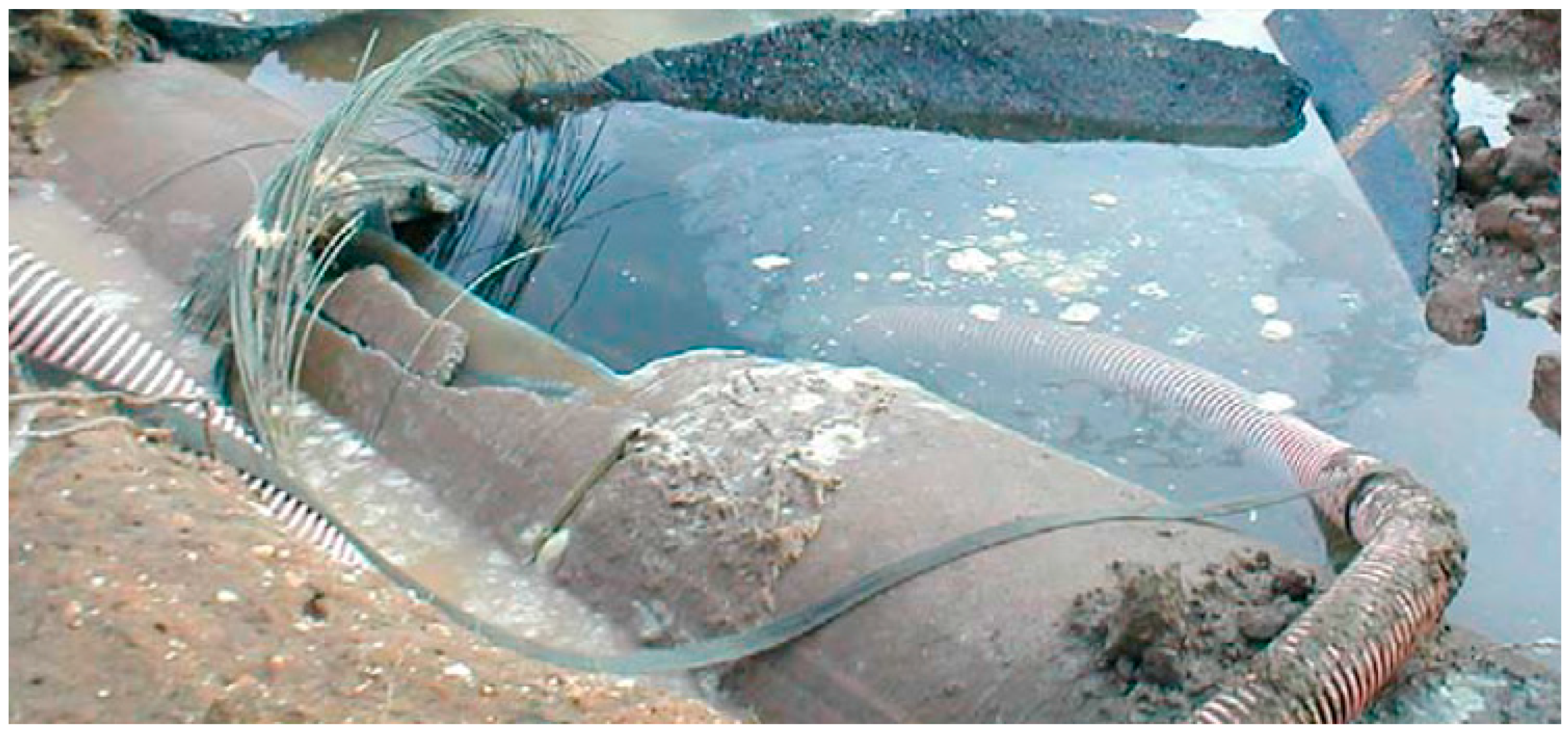
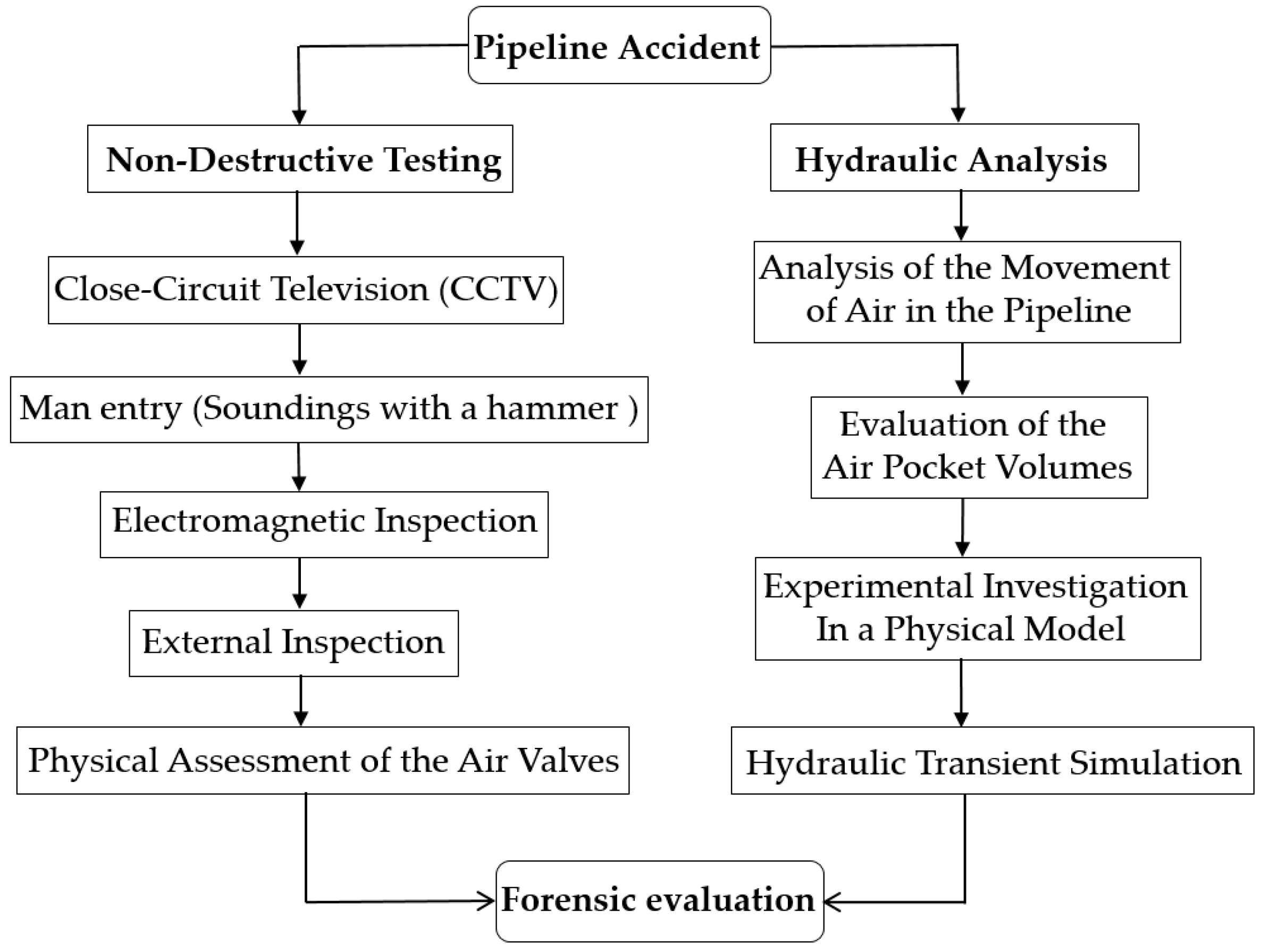

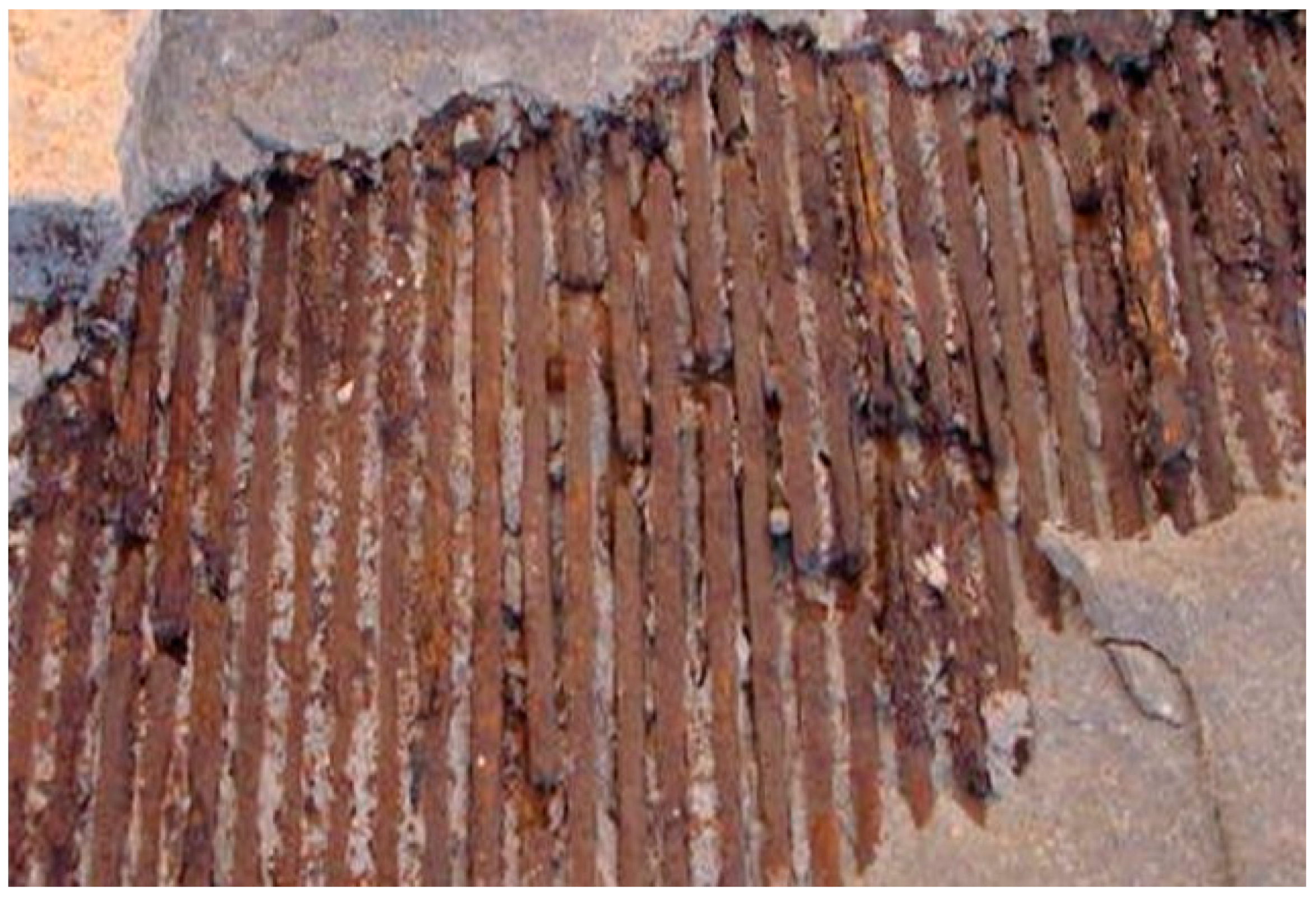
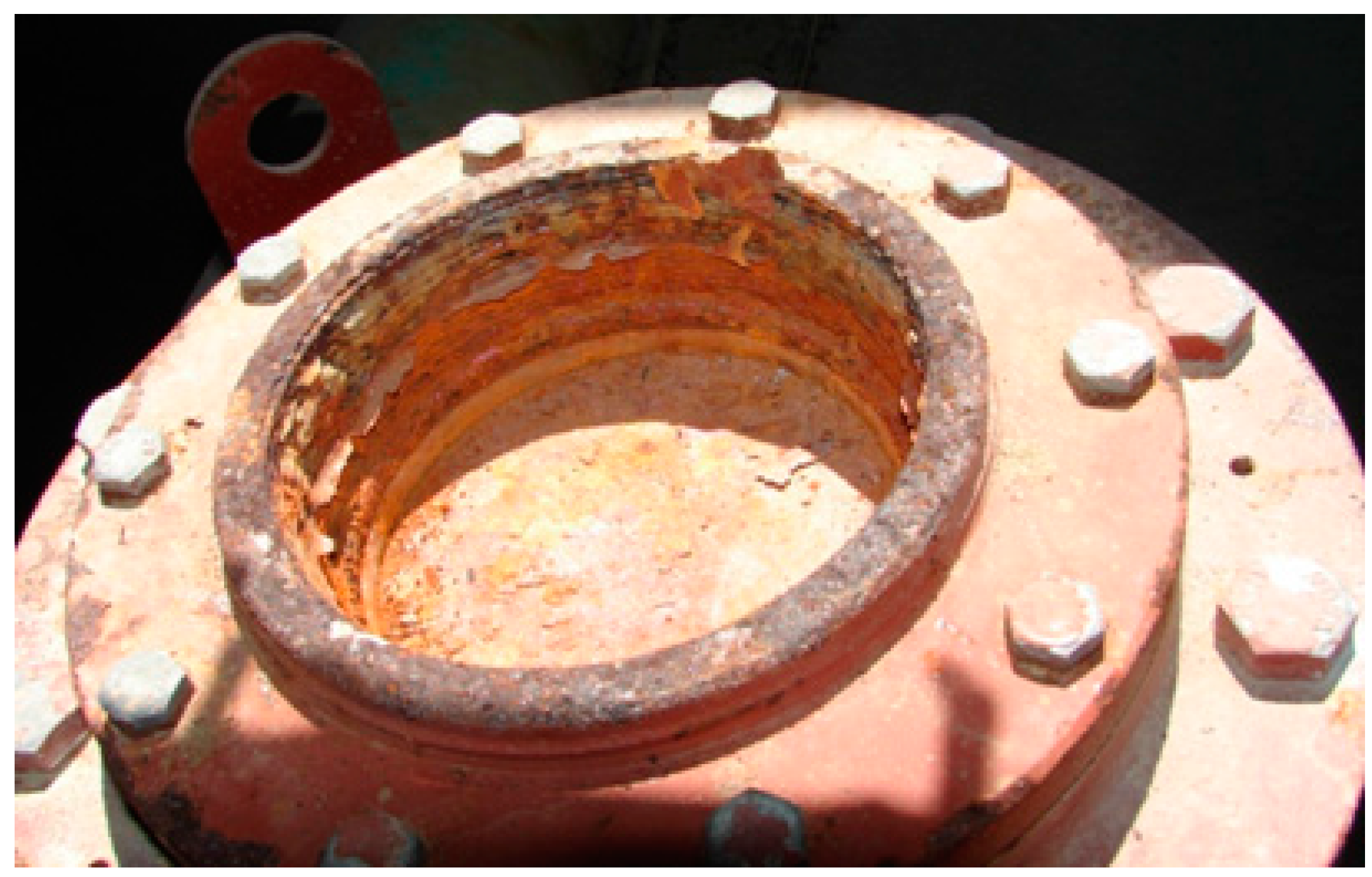
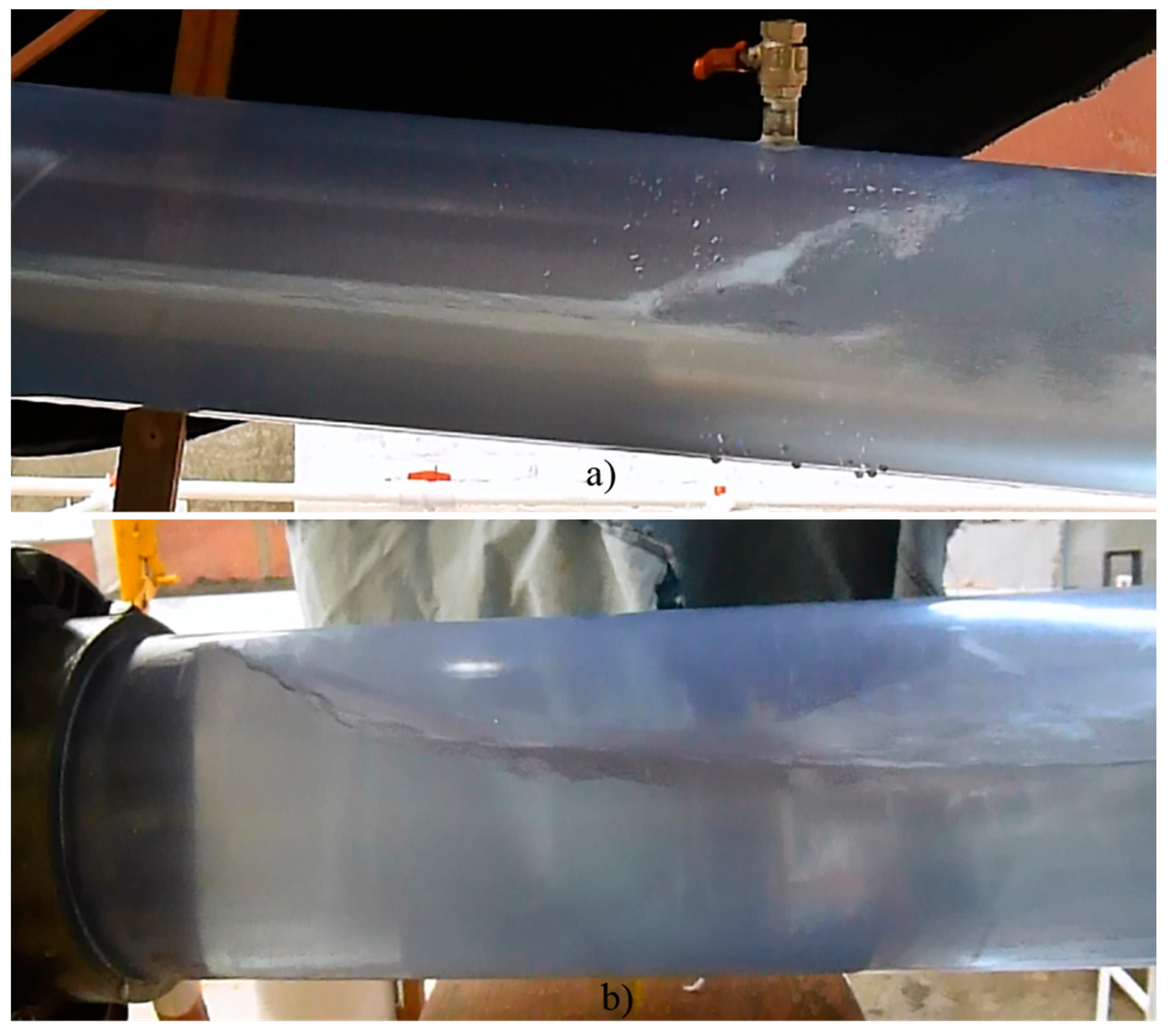
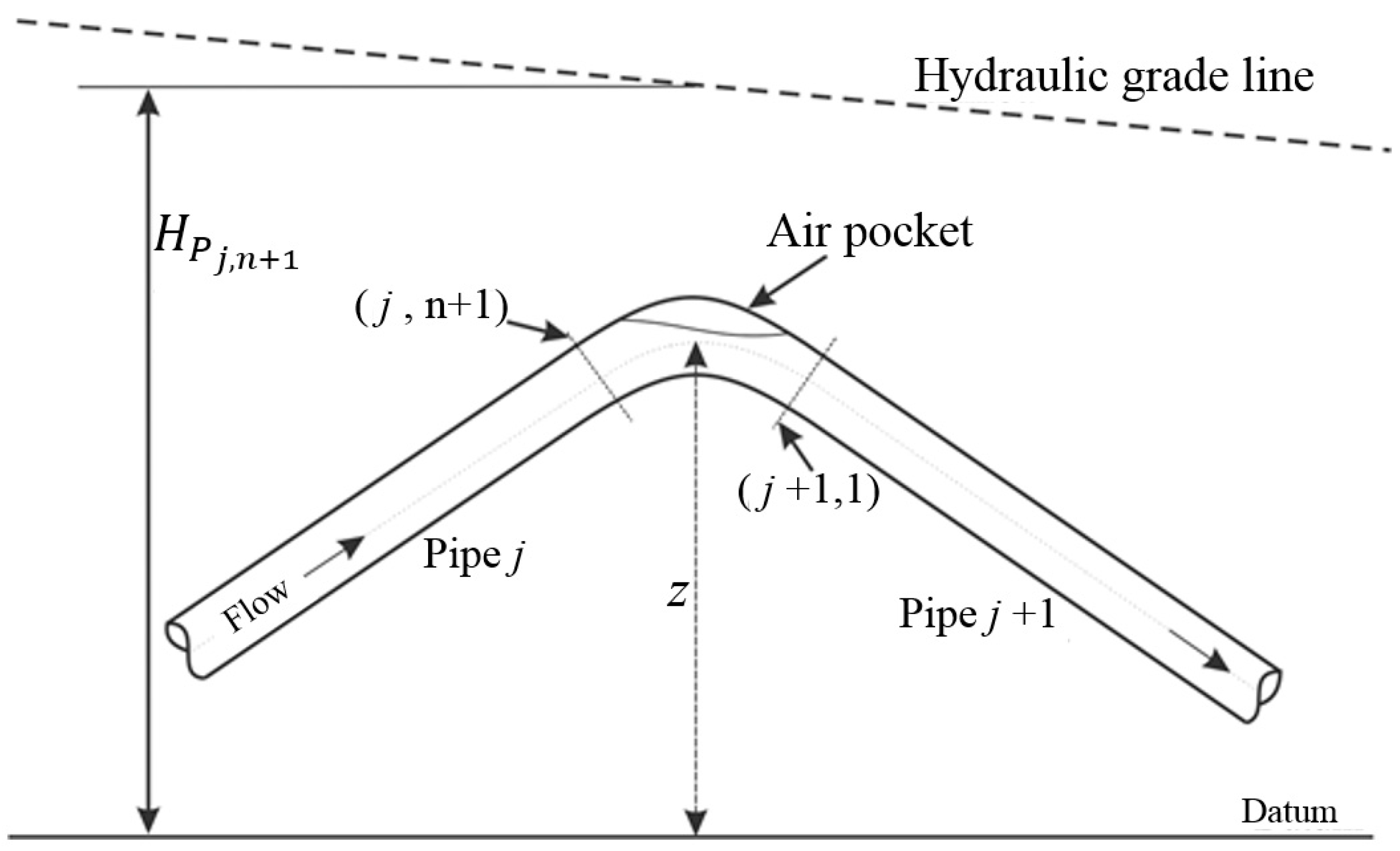
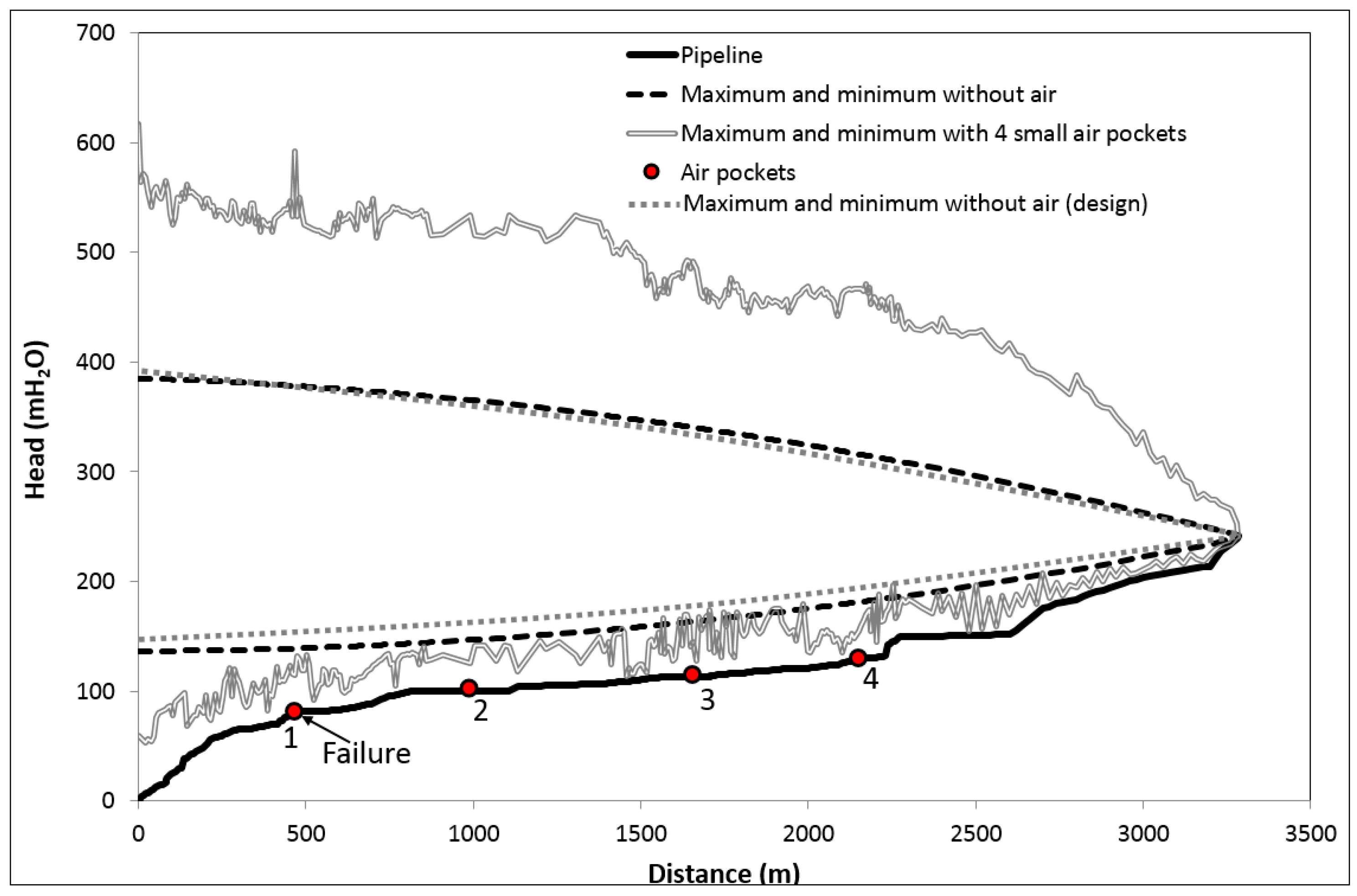
| Air Volume (L) | Length of the Profiles (m) | ||
|---|---|---|---|
| Injected | Equation (2) | Profile Upstream | Profile Downstream |
| Sup = −0.380 and Sdown = 0.103 | |||
| 5.0 | 4.87 | 0.53 | 0.33 |
| 11.0 | 10.73 | 0.53 | 1.52 |
| 18.0 | 17.78 | 0.53 | 3.71 |
| Sup = 0.0021 and Sdown = 0.204 | |||
| 6.0 | 5.82 | 0.72 | 0.61 |
| 10.0 | 9.74 | 0.72 | 1.14 |
| 19.0 | 18.67 | 0.72 | 3.13 |
| Sup = −0.141 and Sdown = 0.109 | |||
| 6.0 | 5.76 | 0.61 | 0.49 |
| 8.0 | 7.74 | 0.61 | 0.78 |
| 11.0 | 10.58 | 0.61 | 1.52 |
| 22.0 | 21.71 | 0.61 | 4.12 |
| Sup = −0.157 and Sdown = 0.126 | |||
| 5.0 | 4.79 | 0.53 | 0.37 |
| 10.0 | 9.63 | 0.53 | 0.86 |
| 17.0 | 16.68 | 0.53 | 3.64 |
| 22.0 | 21.67 | 0.53 | 4.03 |
| Chainage (m) | Elevation (m) | S | Volumes of Air (m3) |
|---|---|---|---|
| 465.80 | 81.31 | 0.103 | 1.513 |
| 990.42 | 101.65 | 0.204 | 1.431 |
| 1656.71 | 115.10 | 0.109 | 1.815 |
| 2152.18 | 129.73 | 0.126 | 1.723 |
© 2016 by the authors; licensee MDPI, Basel, Switzerland. This article is an open access article distributed under the terms and conditions of the Creative Commons Attribution (CC-BY) license (http://creativecommons.org/licenses/by/4.0/).
Share and Cite
Pozos-Estrada, O.; Sánchez-Huerta, A.; Breña-Naranjo, J.A.; Pedrozo-Acuña, A. Failure Analysis of a Water Supply Pumping Pipeline System. Water 2016, 8, 395. https://doi.org/10.3390/w8090395
Pozos-Estrada O, Sánchez-Huerta A, Breña-Naranjo JA, Pedrozo-Acuña A. Failure Analysis of a Water Supply Pumping Pipeline System. Water. 2016; 8(9):395. https://doi.org/10.3390/w8090395
Chicago/Turabian StylePozos-Estrada, Oscar, Alejandro Sánchez-Huerta, José Agustín Breña-Naranjo, and Adrián Pedrozo-Acuña. 2016. "Failure Analysis of a Water Supply Pumping Pipeline System" Water 8, no. 9: 395. https://doi.org/10.3390/w8090395






